⚠️ Caution: If you do not want to read the whole detailed article, you can go at the bottom where we have a table for quick look.
You want to start a newsletter. You have got your ideas, stories and dreams in place. But you are in a dilemma of “where should I publish?”. So, you sit down and do your research.
You want a simple yet powerful platform, one that’s easy to start with, gives you creative freedom, and helps you grow, earn, and understand your readers.
And you come about the two most popular options: Substack or Beehiiv. Substack has been in the space for quite sometime but Beehiiv has gained the traction very quickly, but what is the fundamental difference between the two?
The Fundamental Difference
Substack is a American newsletter founded in 2017 with the goal of creating a space that feels creative and community driven. Simplicity is what sets it apart, writers can focus purely on their voice without any unnecessary tech jargon. It is one of the favourite spaces for Subject Matter Experts, Journalists, High Profile Writers including many award winning writers and Nobel Laureates.
Beehiiv is relatively new, founded in 2021 by few early employees of very successful Morning Brew Newsletter. What sets it apart is its focus on helping creators grow and monetize their newsletter email lists with powerful, modern tools, from referral programs to advanced analytics, it is more suited for growth and monetization.
In short, Beehiiv is for creators who want serious monetization and growth whereas Substack is for creators focused on community building.
Which one is easier to use?
Substack
Substack was built with writers in mind above all else. Its clean, minimalist email editor is simple, you won’t find the complexities of traditional email marketing platforms.
While the editor is straightforward, you can still structure your emails with headers, paragraphs, links, and basic formatting. What you won’t find are custom templates or advanced design tools, every newsletter has a similar look and feel, keeping the experience uniform and reader-friendly.
Writing on Substack feels like you are writing on your personal Journal. It prioritizes clarity, speed, and ease of use over customization. You can start publishing immediately, and your focus remains on crafting engaging content, building your audience, and even monetizing through paid subscriptions, without worrying about design distractions.
It has a relatively simple Home Page.
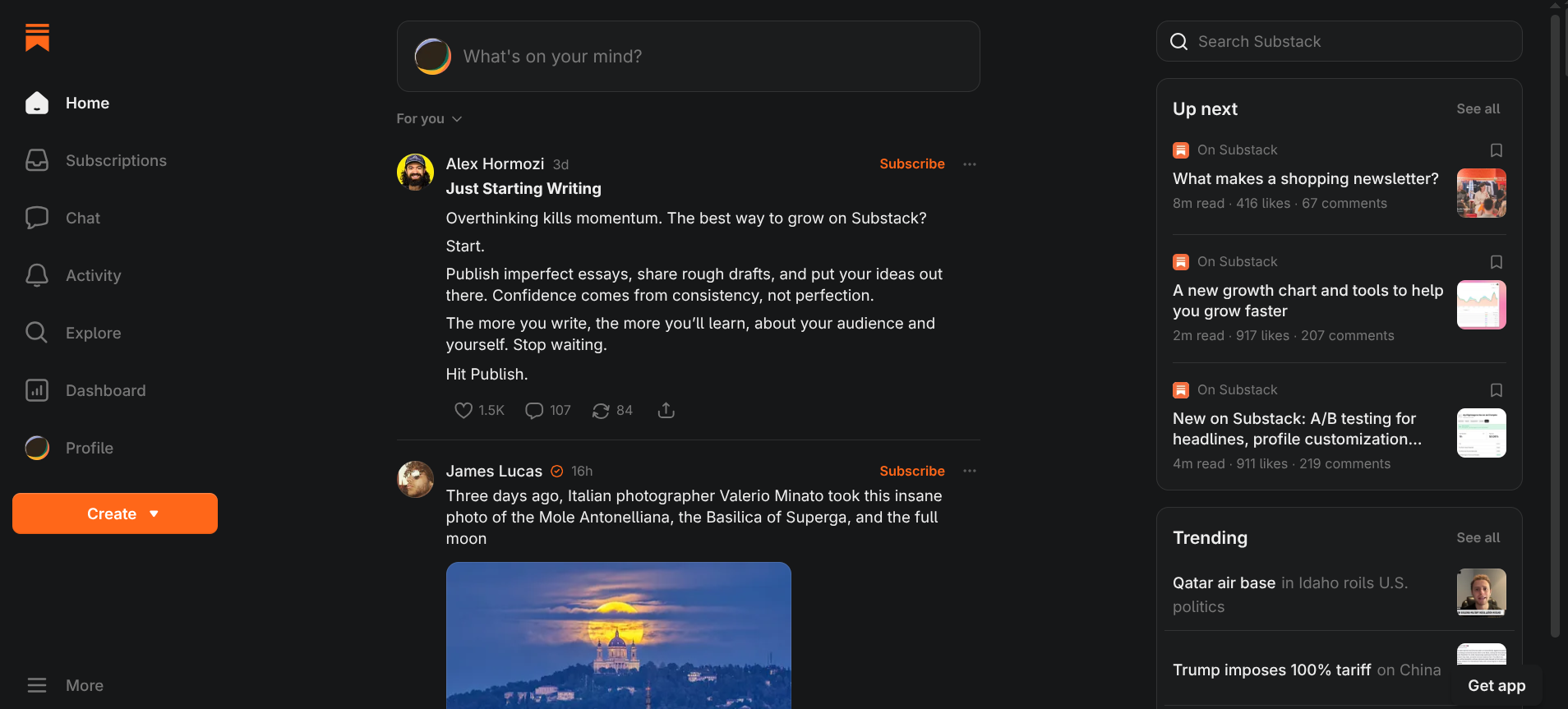
and Dashboard
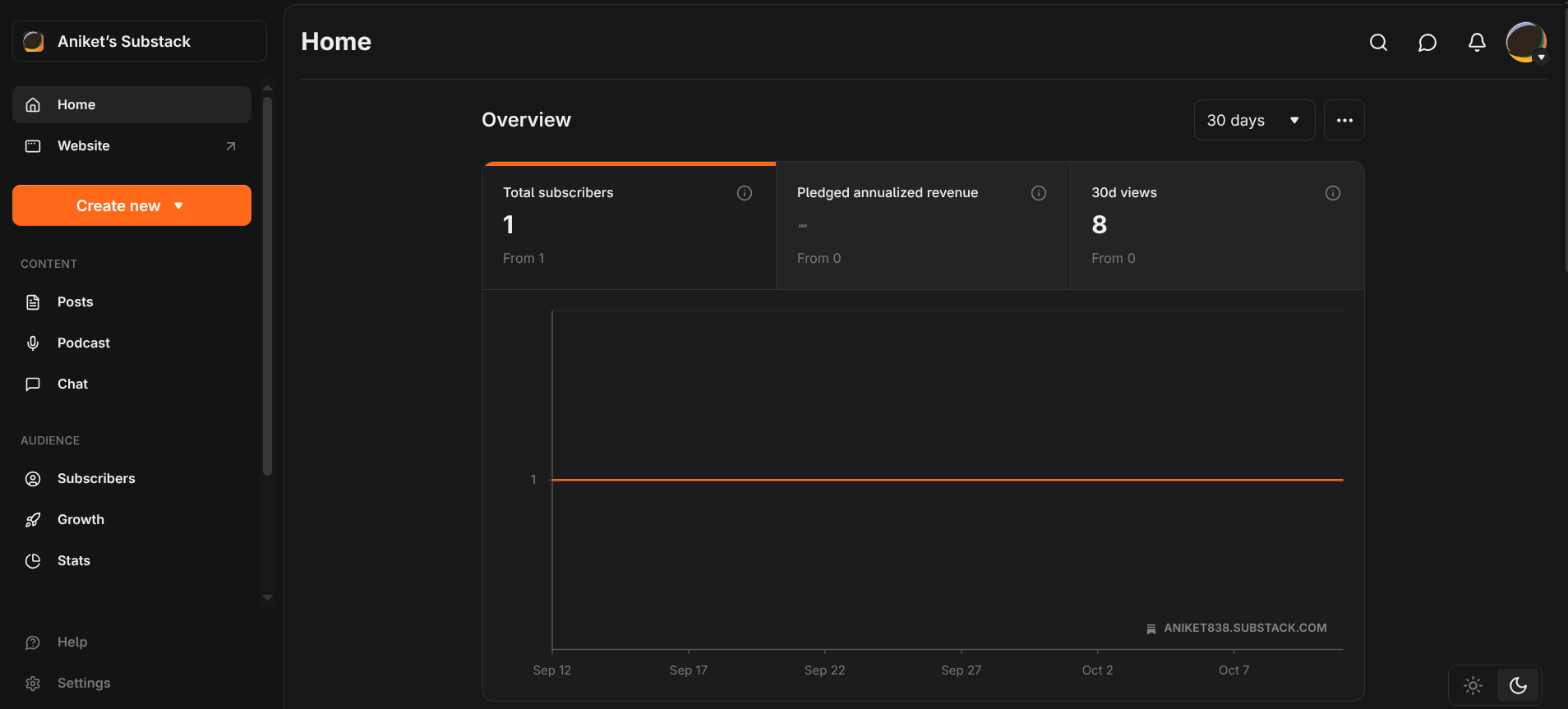
The dashboard provides a quick snapshot of subscribers, revenue and views, simple and limited, but that’s exactly what makes it so user-friendly.
Beehiiv
Beehiiv, by contrast, was built with advanced features to help creators grow and monetize their lists - addressing gaps left by older email platforms.
Its editor is still simple to use, paired with a post settings panel for author, title, and subtitle. Unlike Substack, Beehiiv offers custom templates for branding, though these are limited to premium plans (free users can create and save their own templates). Beyond that, it provides audience segmentation, detailed analytics, and automation, giving creators powerful growth tools but can be a learning curve for beginners.
Email Editor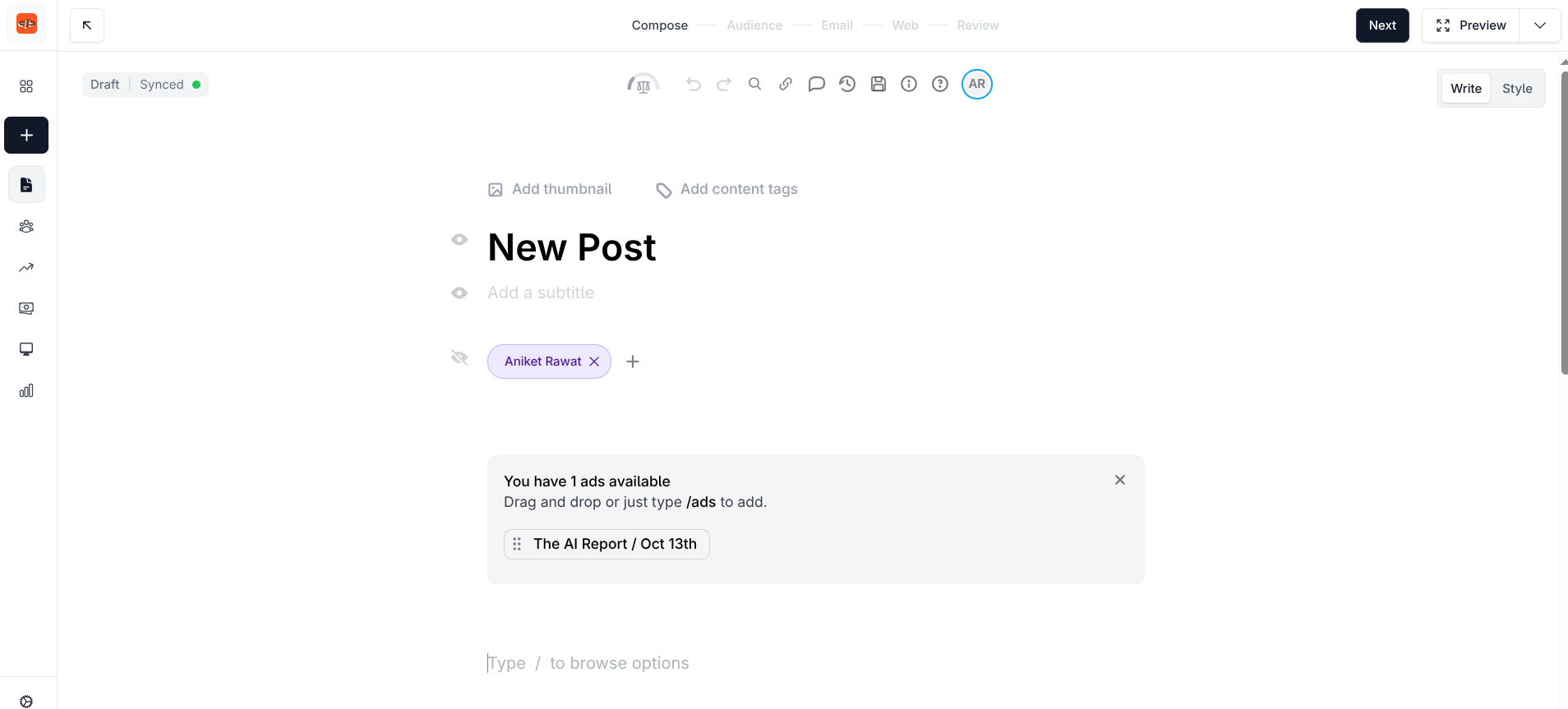
Dashboard
Design and Customization
Substack
Substack’s focus on simplicity and writing means it doesn’t offer much flexibility for creators who want to experiment or grow their newsletters. There are virtually no email templates, so most newsletters end up looking quite similar. The default welcome page is minimal - just a short blurb and a sign-up form and the homepage is a straightforward archive of past issues in a newspaper-style layout.
That said, you can make small tweaks, like adding a logo or changing the background color, to give your newsletter a bit of personal touch.
For example:

Beehiiv
Beehiiv's design options are also limited with some pre-made templates. It does has more options than Substack but still most newsletters look same. There is a Design Lab where you can customize your emails by selecting fonts, header styles, and background colors, giving you more control over the look and feel of your newsletter.
In Beehiiv’s email editor, you can add content blocks using your customized framework including images, buttons, tables, and social media embeds. The editor also includes handy features like an easy to use table builder which can be really helpful, but overall it remains straightforward and uncluttered.
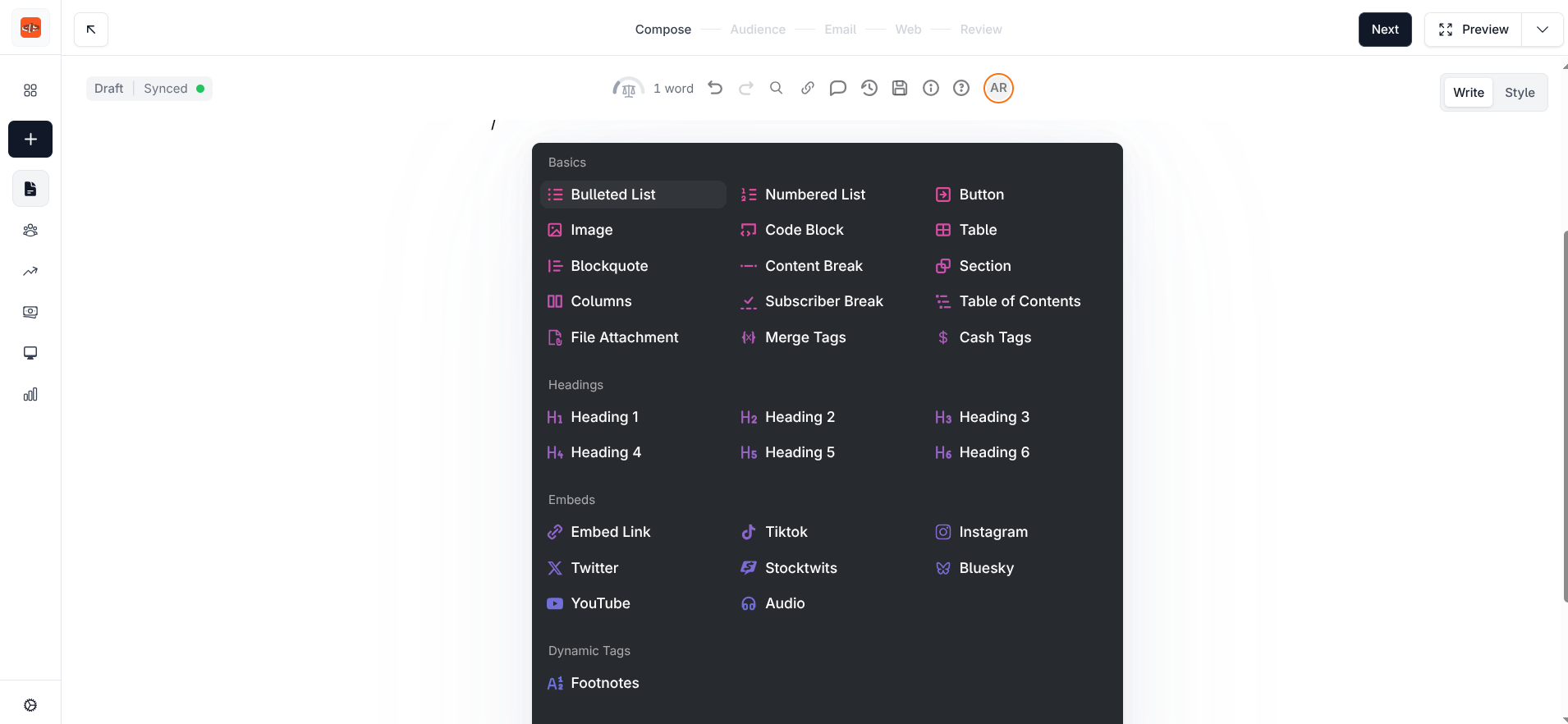
Beehiiv’s email editor
Analytics
Substack
Substack provides a basic stats dashboard that highlights your top subscriber sources, referral traffic, and performance of past emails. However, its analytics are fairly limited compared to more advanced platforms. You can track only a few key metrics like engagement rate, open rate, and click-through rate along with insights like device usage (desktop vs. mobile) and link clicks.
While this is enough for casual writers, creators who want to grow strategically or make data-driven decisions may find Substack’s analytics a bit too minimal.
Beehiiv
Beehiiv on the other hand takes analytics to the next level, giving creators a detailed view of how their newsletters perform and where their readers come from.
Inside the dashboard, you can see everything from total subscribers and growth trends to engagement metrics like open and click-through rates. Beehiiv also breaks down where new subscribers originate, whether from X (Twitter), Instagram, Google, or direct traffic and even lets you filter by campaign or source using UTM data. You’ll find insights on audience activity by country and device type, plus cohort and retention analyses that help you understand how engagement evolves over time.
With visuals showing subscriber growth, engagement funnels, and detailed acquisition reports, Beehiiv’s analytics make it easier for writers to make informed, data-driven decisions about how to grow their newsletters.
So, here Beehiiv is the clear winner.
Pricing
Beehiiv
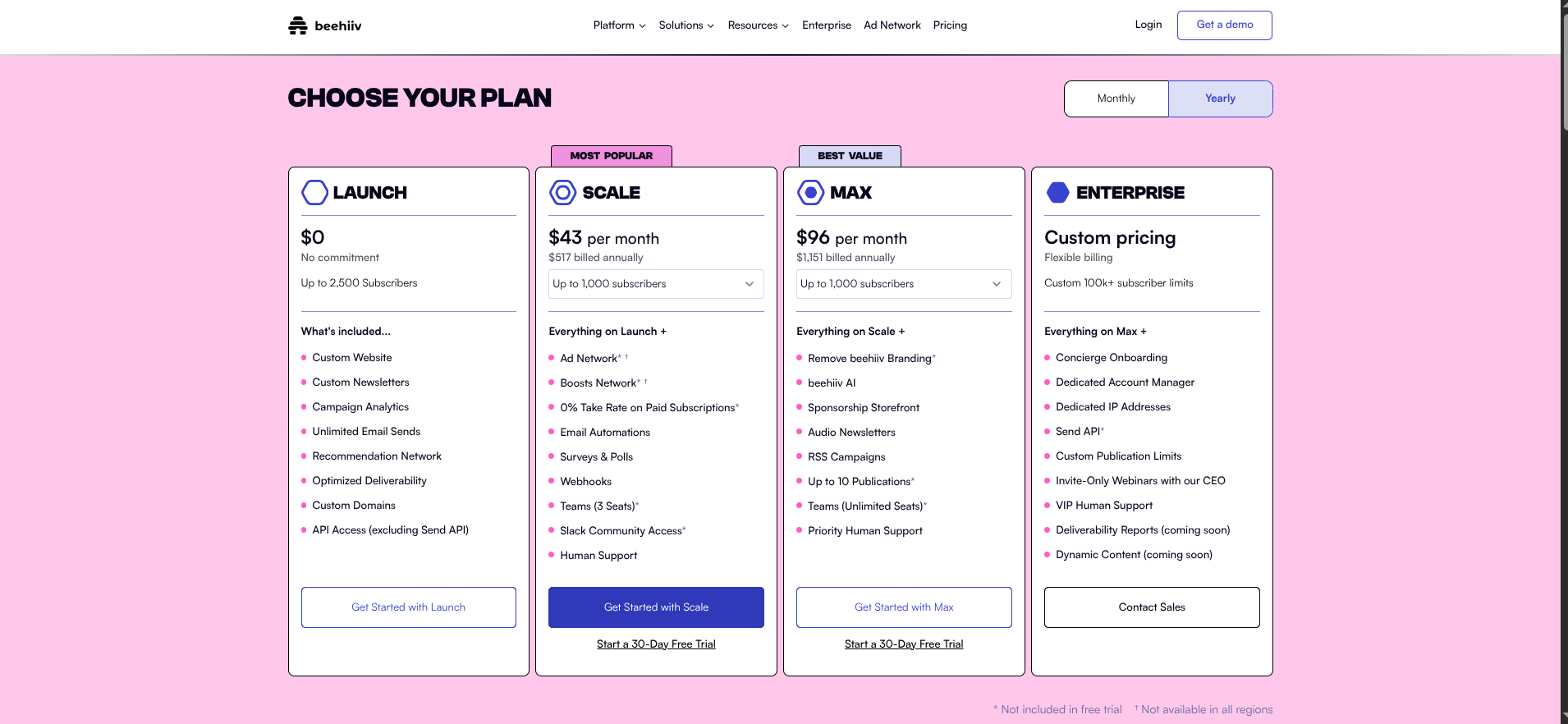
Beehiiv offers a generous free plan that supports up to 2,500 subscribers. This makes it a great starting point for new writers or small publications.
However, features like monetization capabilities, which include the ad network and referral program, custom domains and paid memberships are locked behind Beehiiv’s paid plans. You’ll need to upgrade if you care about SEO or want your own branded domain.
Free Plan: Up to 2,500 subscribers.
For anyone serious about building and monetizing a newsletter, Beehiiv’s pricing feels fair and you get professional-grade tools at a reasonable cost. The Max and Enterprise plans are ideal for organizations managing multiple newsletters, large audiences, or needing a dedicated account manager.
Substack
Substack takes a very different approach. There’s no monthly fee instead, it operates on a revenue-sharing model. You can publish, grow, and even monetize your newsletter for free, and Substack only takes 10% of your paid subscription revenue, plus standard Stripe processing fees.
That means you don’t pay anything upfront which is ideal for beginner or hobby writers testing the waters. However, as your revenue grows, Substack’s commission can add up over time, especially for larger creators.
- Free to start - no subscription cost.
- Substack Fee: 10% of paid subscriber revenue.
- Stripe Fee: Around 2.9% + $0.30 per transaction.
This makes Substack perfect for writers who want a simple, low-risk start but less cost-effective for those earning significant income from their subscribers.
Growth Features
Beehiiv
Beehiiv is built for growth, offering a robust suite of tools to help newsletters scale fast. Key growth features include:
- Automated sequences and subscriber segmentation for targeted campaigns.
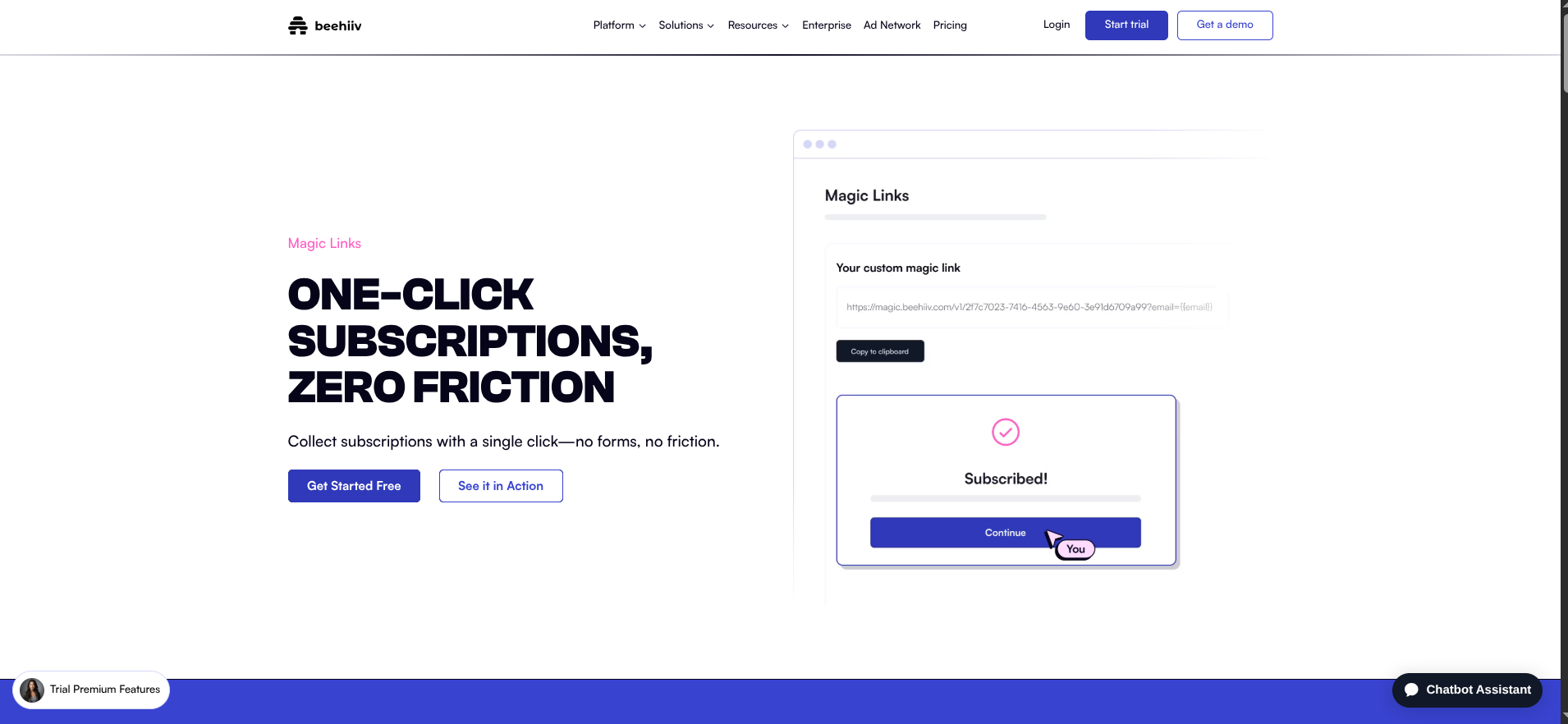
- Referral program and magic links for one-click subscriptions and viral sharing.
- A/B testing for subject lines to boost open rates.
- Integrations with tools like Zapier and Make.com for workflow automation.
- Network recommendations that let creators promote each other directly in the editor.
Together, these tools create a strong ecosystem that fuels organic growth, something Beehiiv keeps improving while many competitors lag behind.
Substack
Substack, on the other hand, is minimalist to a fault. Key limitations include:
- No automation, integrations, or referral programs.
- Basic segmentation (only free vs paid).
- No A/B testing or custom domains.
- Growth relies mainly on organic discovery via Substack’s internal network and RSS feeds.
Growing on Substack largely depends on your existing audience not the platform’s tools.
Here we can say Beehiiv is hands down The Winner!
SEO
Beehiiv
Beehiiv makes SEO simple and effective for most creators, no plugins or tech setup needed.
Key SEO features:
- Custom domain
- URL slug customization
- Meta description customization
- Sitemap
- Canonical tags
- Redirects
- Robots.txt
- Website speed: Excellent (fast and responsive out of the box)
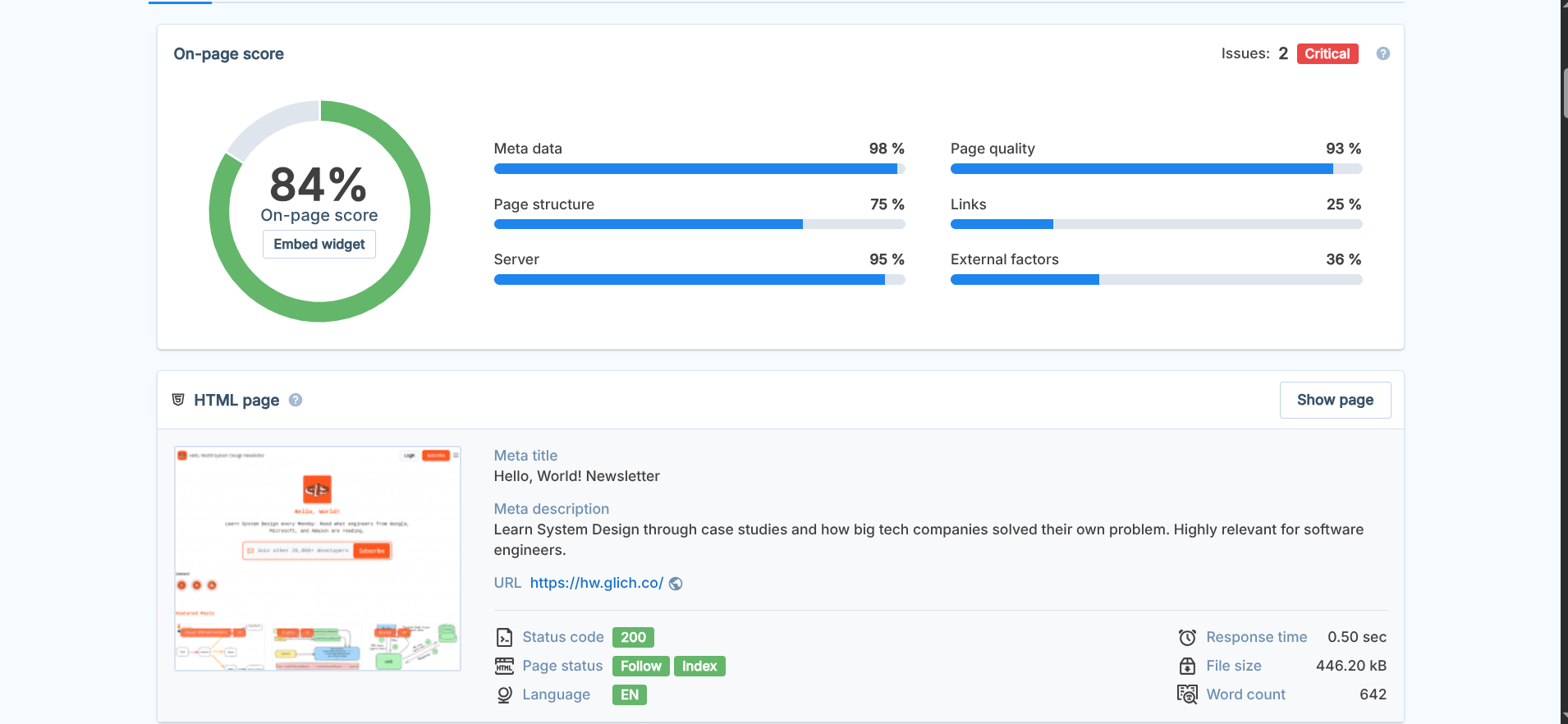 Beehiiv handles the essentials well, giving creators solid SEO performance with minimal effort. Its fast load times and optimized setup make it ideal for users who want visibility on Google without technical complexity.
Beehiiv handles the essentials well, giving creators solid SEO performance with minimal effort. Its fast load times and optimized setup make it ideal for users who want visibility on Google without technical complexity.
However, advanced users might notice a few gaps like no redirects, limited canonical tag control, and no ability to add noindex to individual posts. Still, for most of the users, Beehiiv’s SEO setup is more than enough.
Substack
On paper, Substack offers similar SEO basics but in practice, it underperforms.
Key SEO features:
- Custom domain: (but is paid)
- HTTPS
- URL slug customization
- Meta descriptions
- Sitemap
- Canonical tags
- Redirects
- Robots.txt
- Website speed Good
While Substack includes standard SEO features, publications often struggle to rank well in search results. Many writers have voiced this issue for years, with little visible improvement.
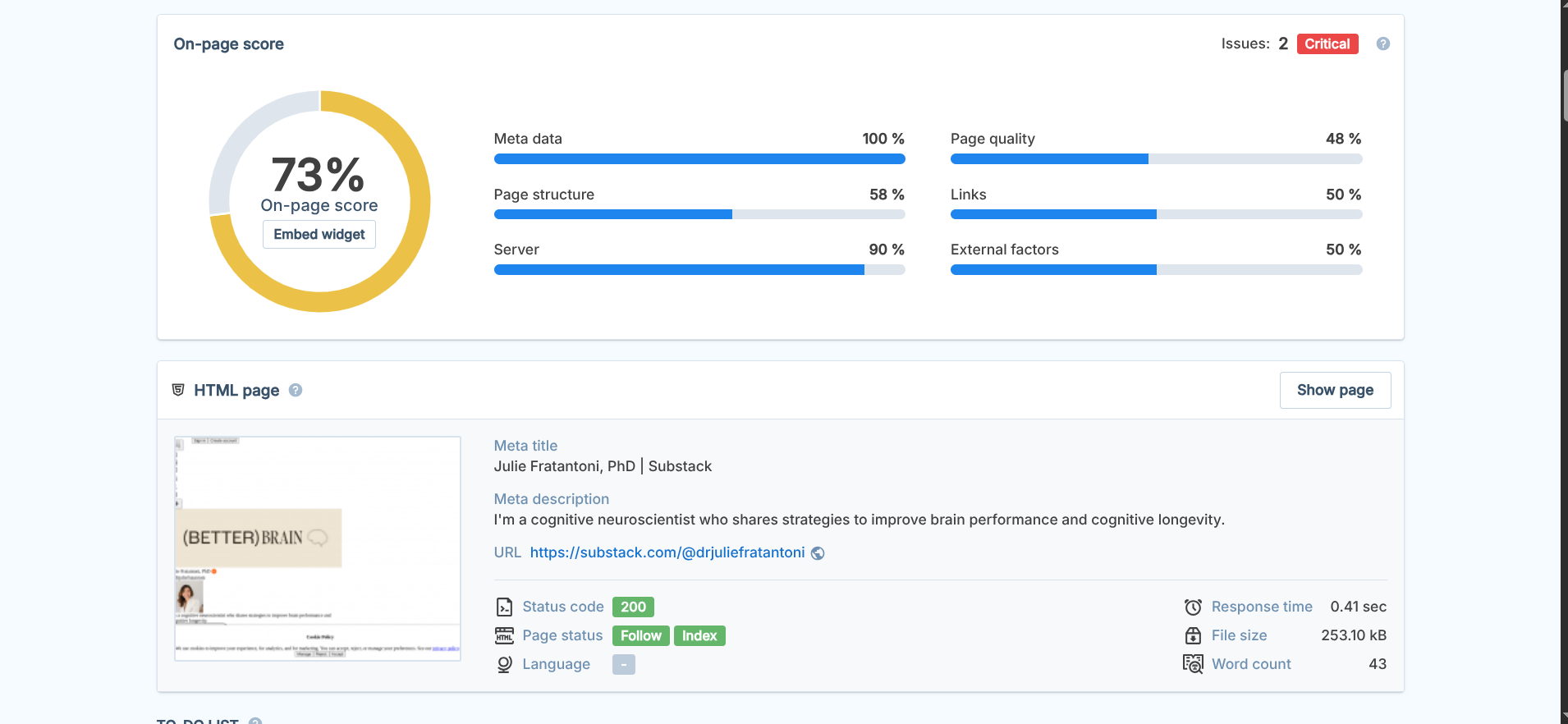
Substack’s main drawbacks are the lack of redirects, limited control over canonical and noindex settings, and poor real-world SEO performance. As one writer joked, “The only way a Substack grows is through tweets.”
So, here also Beehiiv is the Winner.
Extras
There is a small detail most people don’t realize:
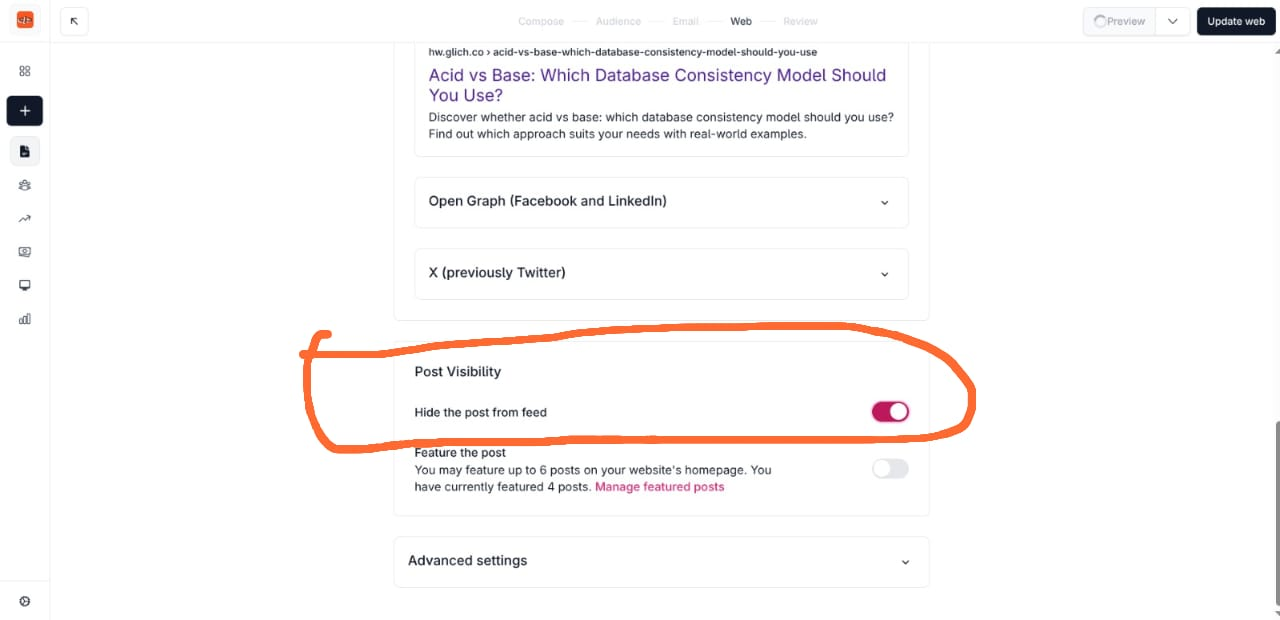 On Beehiiv, you can choose to create either a newsletter or a blog post and decide whether or not to publish it on your public site. This means you can send private newsletters (like promotional emails or updates) without them appearing on your public blog.
On Beehiiv, you can choose to create either a newsletter or a blog post and decide whether or not to publish it on your public site. This means you can send private newsletters (like promotional emails or updates) without them appearing on your public blog.
Before sending an email, Beehiiv gives you the option to mark it as a standalone email, so it’s delivered to subscribers but not visible publicly. This flexibility is perfect for keeping certain emails private while still maintaining a public archive for others.
On the other hand, Substack automatically publishes every post you send.
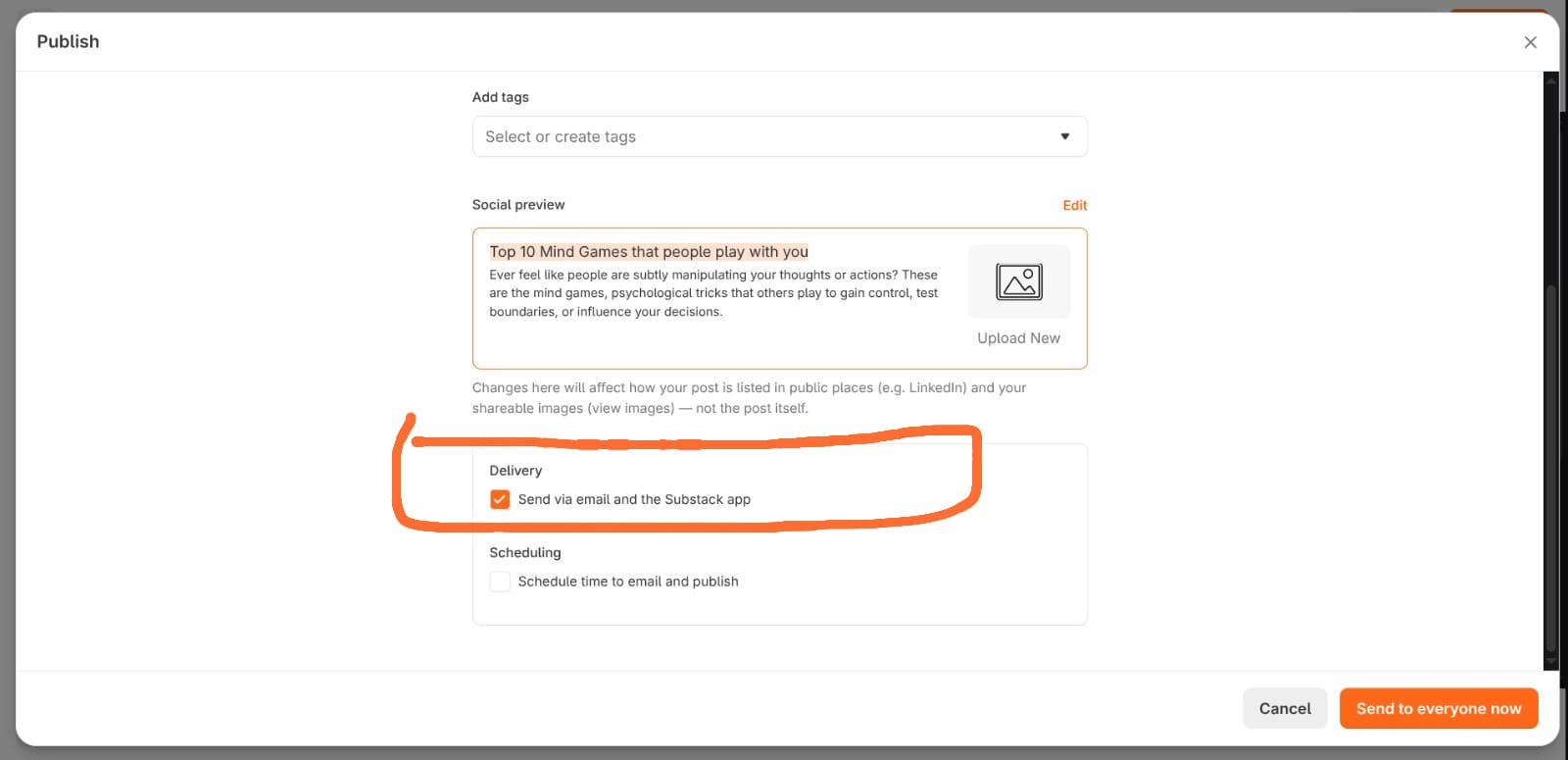 There’s no way to send an email without it also appearing on your public Substack profile. The only control you have is whether subscribers get notified by email when you publish a post.
There’s no way to send an email without it also appearing on your public Substack profile. The only control you have is whether subscribers get notified by email when you publish a post.
This makes Beehiiv even more robust and like a true newsletter + blog platform.
At last, a quick comparison
| Feature | Substack | Beehiiv |
|---|---|---|
| Ease of Use | Extremely beginner-friendly, minimalist editor | Easy to use but with more advanced features, slight learning curve |
| Design & Customization | Very limited, no templates, uniform look, minimal branding options | Offers Design Lab with templates, fonts, and colors, more flexibility and control |
| Analytics | Basic metrics like opens, clicks, and referrals | Advanced analytics with UTM tracking, cohort analysis, and detailed engagement insights |
| Pricing | Free to start, 10% fee on paid subscriptions + Stripe fees | Free up to 2,500 subscribers, paid tiers unlock monetization, domains, and growth tools |
| Growth Features | Minimal - relies mostly on organic discovery within Substack network | Robust tools: referral program, automation, segmentation, A/B testing, and integrations |
| SEO | Basic SEO setup, slower site performance, limited control | Strong SEO setup with custom domains, meta tags, sitemaps, and fast load times |